An unpublished brochure reveals the design of a proposed massive modification to the X-15. The Marquardt Company had by the time of this brochure been studying the ejector ramjet for several years. This propulsion system used a large number of small rocket engines to “pump” a ramjet; this allowed the ramjet to be used at very low airspeed, all the way up to Mach 4+ at extreme altitude. A “supercharged” ejector ramjet added a turbine fan upstream of the ejector rockets. The turbine was powered by a secondary gas generator, and would increase thrust at lower speeds and altitudes. Having the turbine in the airflow would limit the engine to about Mach 4 or a little more; more complicated SERJ designs were produced which would allow the turbine to rotate out of the airflow, permitting even greater speeds.
Marquardt at this time envisioned the use of SERJ engines in everything from point defense interceptors to tactical fighters to strike/recon and strategic penetrators. Marquardt expected that post-1975, Mach 4 would be a necessity. In order to flight-test the engine, it was proposed to modify an X-15 to incorporate a SERJ engine. This engine would replace the XLR-99, and would require some substantial changes:
A large ventral inlet
A re-shaped ventral fin
Revised main skid landing gear
Altered propellant tanks
The SERJ engine would burn JP fuel and hydrogen peroxide oxidizer, eliminating the need for cryogenic equipment. The modified X-15 would be carried to altitude beneath the wing of the existing B-52 carrier plane. No in-flight oxidizer topping would be needed. Due to the deep throttling capability of the SERJ engine, it could be started while still attached to the carrier aircraft pylon.
Inboard views of the SERJ-equipped X-15
Marquardt via W. Escher
————-
Artists impression of the SERJ equipped X-15 (Leo Skubic, Marquardt)
Marquardt via W. Escher
————–
North American had produced designs of a stretched and delta winged X-15 (the middle design). Marquardt expected that this aircraft could also be equipped with a SERJ engine, producing greater performance. Further improvements still could be had by stretching the delta X-15, and adding a second crewman. Performance enhancement was not in speed or altitude, but in duration. An aircraft beyond this would be a truly operational military vehicle.
Marquardt via W. Escher
——————
SERJ-equipped X-15 display model
Marquardt via W. Escher
————
Top: The SERJ-176-E-1A engine was remarkably compact.
Bottom: Marquardt and Aerojet built and successfully static tested subscale SERJ engines.
Marquardt via W. Escher
————–
SERJ-equipped X-15 display model
From Boeing Historical Archives
————
SERJ-equipped X-15 display model
From Boeing Historical Archives
———–
Reference: ” X-15 SERJ Precursor to Mach 4-plus,” unpublished preliminary brochure, The Marquardt Company, June 1969
27 Responses to “X-15 with Supercharged Ejector Ramjet: Marquardt, June, 1969”
Sorry, the comment form is closed at this time.
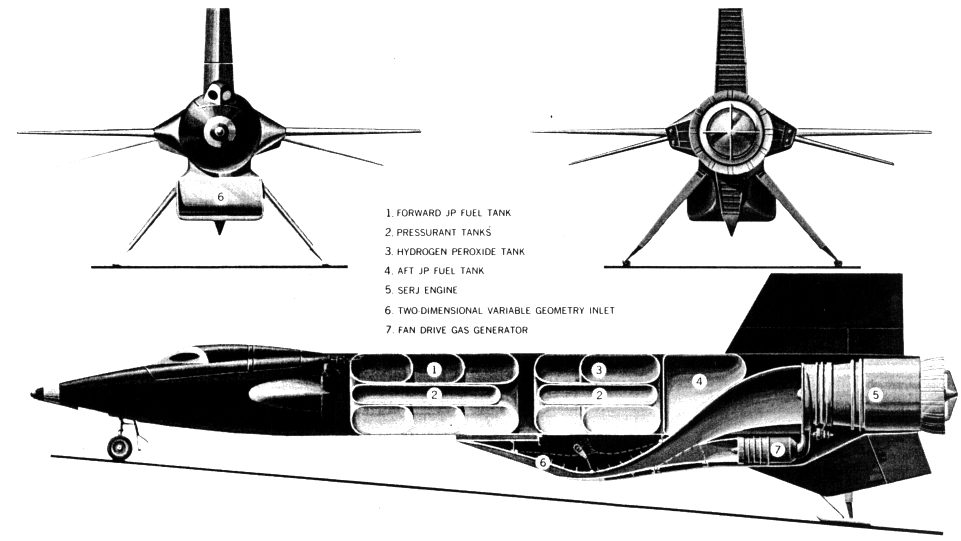
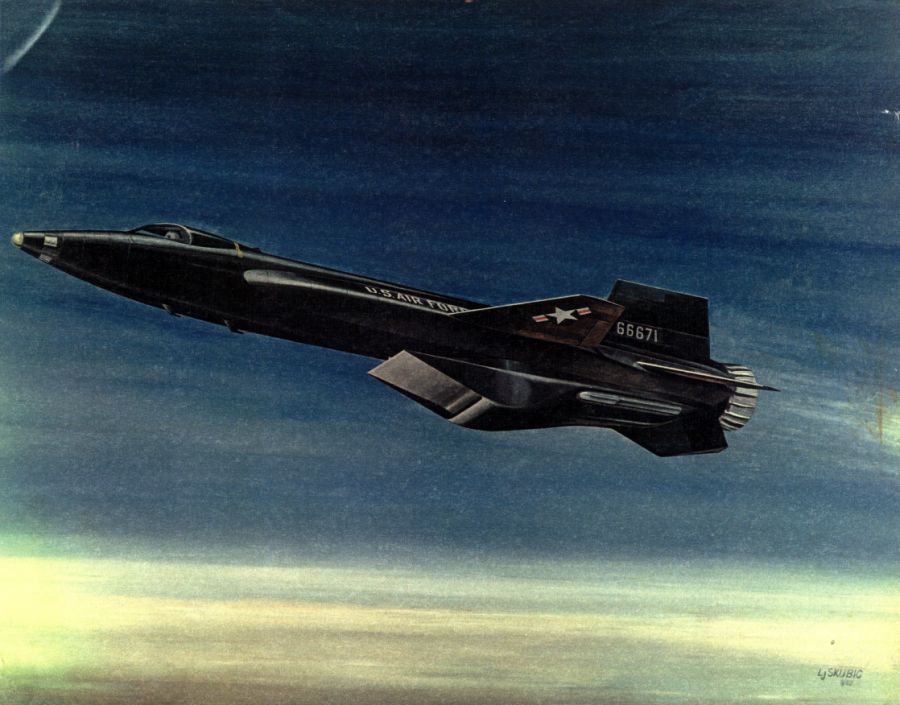
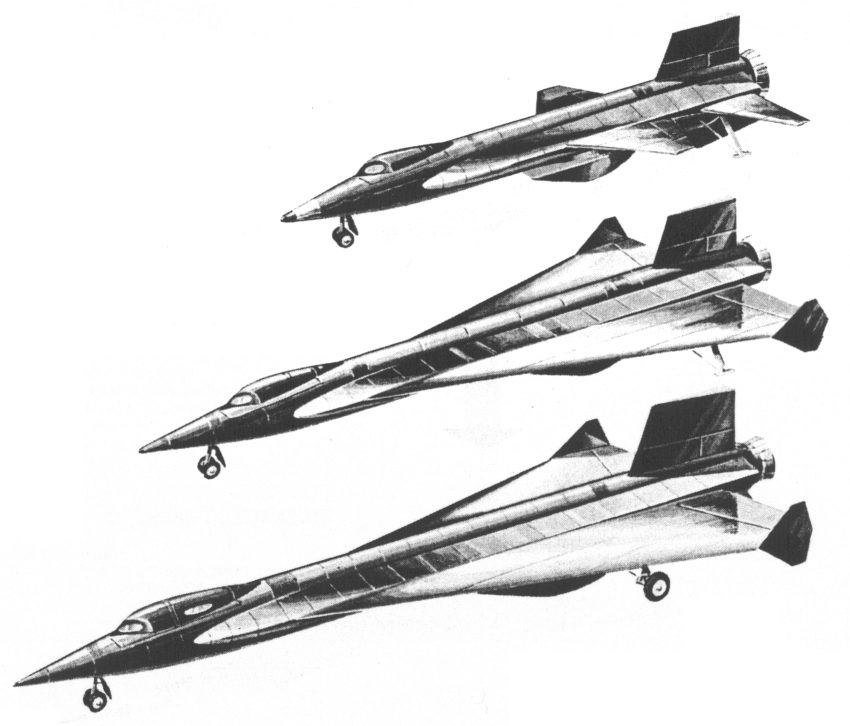
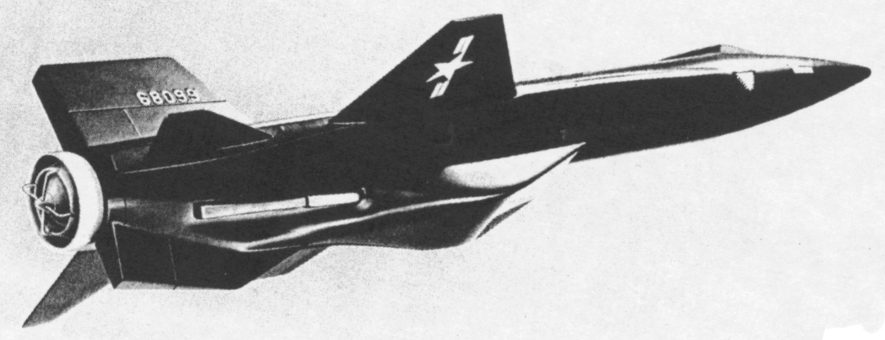
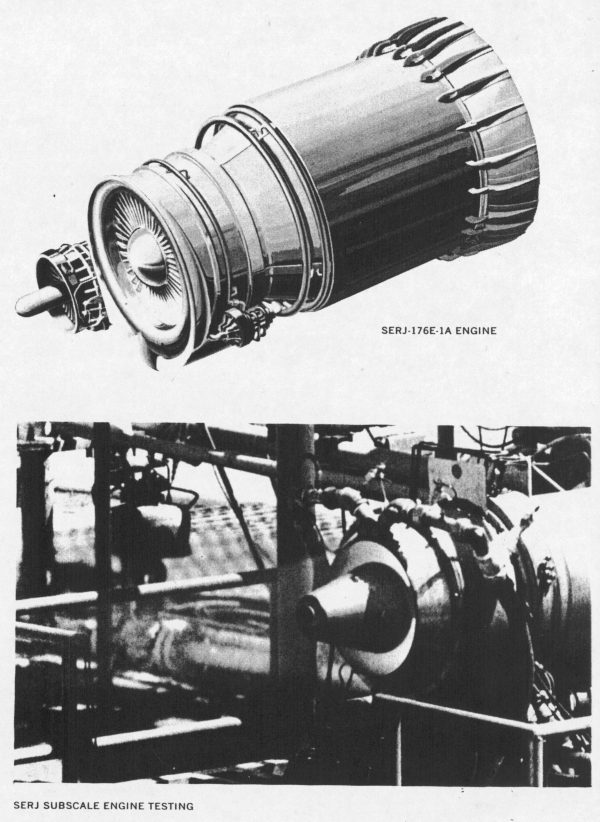

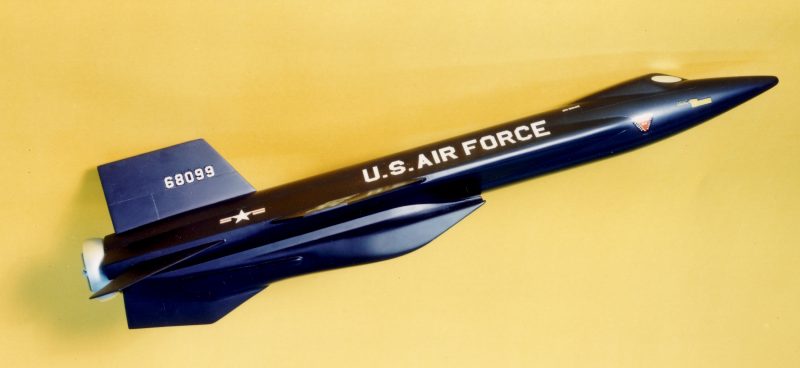
hmmm 1969…
this was right before they cancelled the D-21b drone….
maybe they were thinking a manned replacement for the D-21 drone with the stretched/delta versions?
I know about the same time they were looking closely into replacing the SR-71 as well..it didn’t happen until 1989, but a replacement for both systems would have been attractive to the air force and the CIA.
as a bonus, the whole program could have been cloaked in a “enhanced X-15 test program”
I wonder if Boeing kept all the information on the program or if they threw it out?
It was NAA’s data for several decades. And we all know what happened to *that.*
I’m not sure I understand how this would work. What do you mean by “pumping” the ramjet? Would the ejector rockets increase the velocity of the airflow before it entered the ramjet’s combustion chamber?
> Would the ejector rockets increase the velocity of the airflow before it entered the ramjet’s combustion chamber?
Exactly. At zero airspeed, a ramjet produces zero thrust. But if you stick a rocket in the front of it, shear forces will cause the rocket exahsut to “drag” the surrounding air along with it. This is and of itself can increase the thrust of the rocket. Adding fuel injection down the line makes it a ramjet.
If there really were black world aircraft hypersonic projects in the 1980’s, this would be a really good candidate for how they were propelled.
> …shear forces will cause the rocket exahsut to “drag” the surrounding air along with it.
What would cause these shear forces? Is it due to the pressure differential between the rocket exhaust and the surrounding air or something else entirely? And finally, won’t this increase thrust by decreasing specific impulse? Sorry about asking so many questions, but I didn’t get to cover anything too interesting in my fluid mechanics class.
This is a *supercharged* ejector ramjet. There’s a separate small jet engine (you see one in the picture in the side, number 7 in the side cutaway) that makes hot high velocity gas that then is directed at the tips of the big compressor (that’s called a tip turbine) and makes that big compressor turn and compress the main airflow for the ramjet.
You had it all here earlier where I got the information, what’s the new bit?
http://www.up-ship.com/blog/apr/extras/serjx15.htm
It’d be interesting to see how it operated at different speeds. Fast enough you can just shut down the separate jet and let the main compressor windmill as the inlet will compress enough by itself.
The basic idea behind all these fancy air turbo rockets and ejector ramjets etc is to avoid putting a/the turbine in the free air stream after the main chamber [like it is in a normal jet engine], because it would melt at high speeds / temperatures.
I would love to see the actual cross section of the engine main chamber itself, number 5. Why does it still need an ejector if it has a compressor already? Is the flow still divided radially inside?
How much is there testing data of pure ejector ramjets anyway? It’d be quite simple as you only need a simple rocket inside a tube. I assume the low speed thrust is really really lousy.
> You had it all here earlier where I got the information, what’s the new bit?
The new bit is that it’s now on the blog. Woo.
> It’d be quite simple as you only need a simple rocket inside a tube.
Sadly, a simple rocket ina tube does not work terribly well.
Performance of the ejector is a function of a number of factors, including the effective surface area of the rocket exhaust plume, which can be envisioned as a cone for a standard nozzle. But the surface area of a single rocket plume of thrust X is less than the surface area of two rockets of thrust 0.5X. And far less than the area of, say, 100 rockets of thrust 0.01X. The ulitmate ejector rocket would have a bagrillion microscopic engines all roaring away. Ejector performance would be fantastic… but cost and complexity would be impressive.
Ah, that then explains the annulus of small nozzles and the central “onion”. Thanks!
Any numbers on thrust, etc?
GravityLoss:
>I would love to see the actual cross section of the engine
>main chamber itself, number 5.
>Why does it still need an ejector if it has a compressor
>already? Is the flow still divided radially inside?
Here’s a 1974 patent by Escher for the “standard” Supercharged Ejector Ram Jet Engine design:
http://www.freepatentsonline.com/3812672.pdf
Both in answer to your question(s) and MrTolliver’s the “Ejector” is the basic cycle of the engine using the rocket both for compression and for thrust until the ramjet engine can take over. The “supercharger” allows the ejector to be more efficent while providing a (possibly in most cases really depending on the size and performance capability of the compressor fan) low-fuel consumption “cruise” mode though that isn’t needed for most missions envisioned to use ERJ/SERJ powerplants.
MrTolliver: The rocket powered ejector ramjet is also called the Air Augmented Rocket Engine and yes this increases overall thrust and lowers-isp by entrainment of air into the rocket exhaust. The “ramjet” portion acts like an ‘afterburner’ for the rocket engine so that if the rocket is being run ‘fuel-rich’ the entrained air mixes with the unburnt fuel and then is burned further down the duct increasing both thrust and isp.
Randy
Using the new Google patent search engine turned up this under “ejector ramjet” which appears to be pretty close in design to the one shown mounted on the X-15: http://www.google.com/patents/about?id=xj8QAAAAEBAJ&dq=ejector+ramjet
…right down to the underbelly intake.
Patent #3690102 from 1970 shows a design that looks a lot like the simulated “Scramjet” that was mounted on the X-15’s ventral fin.
Interest in the concept still exists if the patent dates are anything to go by.
That’s great Randy. So the ejectors worked with decomposed peroxide. And it had many modes of operation for different regimes.
Didn’t you Scott actually work on some ramjet demonstration that failed because some of the booster solids had ignition problems… It’s vanished from the net. Shades of the Enzian some 50 years earlier with multiple off-center solids?
I ran into the solid-fueled ejector ramjet patents while going through the stuff that Google patent search turned up.
A solid-fueled rocket-ramjet formed the propulsion system of the Soviet SA-6 “Gainful ” SAM, which was pretty successful.
Enzian’s problem wasn’t non-ignition of the booster solids, but rather that they couldn’t get consistent thrust or burn time out of them.
One or more of the four boosters would burn faster than the others, leaving the missile out of control with some burning and others burnt out before they could be jettisoned.
The boosters on the Ba-349 Natter suffered from the same problem.
> Any numbers on thrust
32,000 lbs thrust.
> Didn’t you Scott actually work on some ramjet demonstration that failed because some of the booster solids had ignition problems…
Among other problems, yes, but ignition of the solids was the proximate killer.
> It’s vanished from the net.
Not surprising, given the nature of the company and it’s “leadership.”
Here’s one of the solid-fueled rocket ejector ramjet patents:
http://www.google.com/patents/about?id=13VtAAAAEBAJ&dq=ejector+ramjet
Looking at the Google-found patents in chronological order is fun, as the concept goes nearly as far back as the first afterburners for turbojets.
Surprisingly, the concept of the pulse-detonation engine shows up at a very early date also, with strange pulse jet/rocket concepts.
The one I’d _really_ love to know more about is this little oddity, where coating the interior of a ramjet intake with polonium isotopic paint radically changes the entire drag aspects of the air coming into it:
http://www.google.com/patents/about?id=–40AAAAEBAJ&dq=Of+polonium
I’ve heard about using isotopic paint coatings for reducing the RCS of an aircraft by ionizing the air around it, but having the alpha particle emissions change its drag as it passes through the air?
Check out patent 2,992, 981.
I’ve realized a bunch of drawings related to X-15 SERJ, if you want I can post you.
Sure!
Observer said:
“Check out patent 2,992, 981″
So that’s what the reactor looked like internally.
It’s pretty simple in design really.
That got at least as far as a full scale mock-up of the reactor and jet engines, although I don’t know if they ever cranked up a working reactor and actually test ran the jet engines off of it.
This Lockheed one looks a lot like the ‘Black Triangle” UFO, particularly since when the rotors are going around they wouldn’t be clearly visible:
http://www.google.com/patents/about?id=jACsAAAAEBAJ&dq=4,802,639
I wonder if it was some sort of sub-scale concept test aircraft, sort of like the Have Blue.
It would make a interesting model kit also.
> This Lockheed one looks a lot like the ‘Black Triangle” UFO, particularly since when the rotors are going around they wouldn’t be clearly visible
And when the rotors are going around, it wouldn’t look like a triangle.
What’s interesting to me about the GE nuclear engine patent is a lot of specifics about a/c weights, total thrust (only 26,000 lb), altitude (only 15,000 ft cruise), and speed (only 300 mph). From an installation that weighed well over 50 tons.
Scott I,ve just the drawing via pm.
Admin said:
“And when the rotors are going around, it wouldn’t look like a triangle.”
It would look like a triangle with a blurred edge as the upper and lower sections the rotor blades are attached to lined up with, and then projected beyond the edges of, the triangular fuselage.
The rotational speed of the upper and lower rotors may be higher than is found in a normal helicopter, due to their fairly low length compared to their width generating lower lift.
A purported “Black Triangle” photo taken in Belgium in 1989 shows strange blurring of the ventral tip lights:
http://3.bp.blogspot.com/_7LKddcpz1nw/SgQKHrDSCaI/AAAAAAAAB10/xsfAEg8wXJ4/s400/BelgianTriangle.jpg
Which could be due to the rotor blades crossing over them as the photo was taken. The lights on the underbelly could well be used to illuminate the ground under the aircraft during vertical takeoff and landing.
Figures # 5 and 8 in the patent show that the edges of the fuselage are sharp-edged triangular and made up of some sort of segmented structure, like one would expect if the fuselage edge had some sort of radar-absorbent design.
The upper air intakes for the turbine engines can be seen to be semi-submerged in the fixed central section of the fuselage in figure # 1 and 2, and equipped with intake grills like on the F-117, also for stealth.
One feature not shown in the patent is any sort of landing gear, which would have to be housed in the fixed center disc on the aircraft’s bottom, to allow it to keep its lower rotor blades clear of the ground during takeoff and landing.
Pitch and roll control appear to be handled by vectoring the exhaust of the aircraft’s turbine engines, either together or in opposition to each other.
Figure # 4 seems to show the rotor blades/canard-wings also have some sort of leading edge segmented construction when they are locked in position for forward flight. Given the sweep angle on the canards when locked, forward speed must be what? 500-600 mph?
I suspect the rotors are intended to be driven by the exhaust or fan air from the engines via a free turbine mounted around the periphery of the fixed center disc sections, somewhat like what was done on the Avro flying disc projects. When taking off and landing, engine exhaust probably exits around the periphery of the lower fixed disc, angled outward so as not to damage the landing gear with its heat while adding its vertical thrust to the lift generated by the rotors.
Once airborne, the exhaust/ fan output would be diverted to the aft nozzles as the rotors were slowed down and locked in the forward flight position.
Transitioning to this mode must be tricky to say the least as far as maintaining control goes.
I’m currently building a 1/10 semi-scale model of the SERJ X-15 using mini augmented combined cycle propulsion.